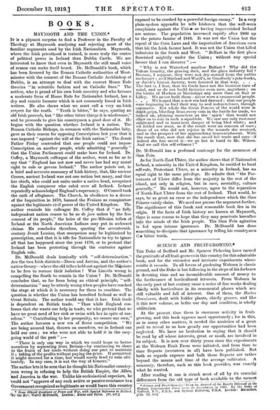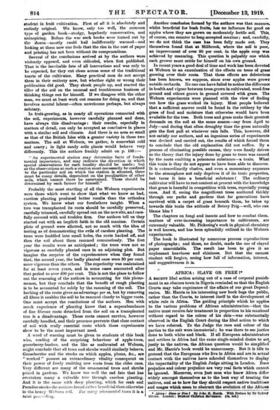SCIENCE AND FRUIT-GROWING.*
THE Duke of Bedford and Mr. Spencer Pickering have earned the gratitude of all fruit-growers in this country for this admirable book, and for the extensive and intricate experiments whose results it records. To all lovers of gardening Woburn is classic: ground, and the Duke is but following in the steps of his forbears in devoting time and no inconsiderable amount of money to the furtherance of horticultural interests. From Woburn in the early part of last century came a series of fine works dealing chiefly with horticulture in its ornamental phases which are still valuable and full of interest. One of them, the Hortus Gramiueue, dealt with fodder plants, chiefly grasses, and like it this new volume, as befits our day and condition, is wholly utilitarian.
At the present time there is enormous activity in fruitgrowing, and this book appears most opportunely ; for in this, as in many other matters, it needed the anxieties of a great peril to reveal to us how greatly our opportunities had been neglected. We have no hesitation in saying that it should be read by all whose interests, great or small, are involved in its subject. It is now over thirty years since the experiments at the Woburn Fruit Farm were initiated, and from time to time Reports (seventeen in all) have been published. But both as regards expense and bulk these Reports are rather beyond the means and time of the average cultivator. A summary, therefore, such as this book provides, was exactly what he wanted.
After reading it one is struck most of all by its essential differences from the old type of book available to the earnest
Student in fruit cultivation. First of all it is absolutely and entirely original. We know, only too well, the common type of garden book—stodgy, hopelessly conservative, and
uninspiring. Before the war such books were turned out by the dozen—mostly could trail indifferently warmed—and looking at them now one feels that the rise in the cost. of paper and printing has not been without its compensations.
Several of the conclusions arrived at by the authors were violently opposed, and even ridiculed, when first published. That is the inevitable fate of all innovations and was only to be expected, for they cut clean across some of the traditional tenets of the cultivator. Many practical men do not accept them in their entirety now, but whether right or wrong their publication did good. They shook people up, and started the tiller of the soil on the unusual and troublesome business of thinking things out for himself. If we disagree with the other man, we must at least work out reasons for doing ao, and that involves mental labour—often unwelcome perhaps, but always salutary.
In fruit-growing, as in nearly all operations connected with the soil, experiments, however carefully planned and done, have always this disadvantage : their results, especially in matters of detail, can only be accepted as conclusive in places with a similar soil and climate. And there is no area so small as that of the British Isles with a greater variety in these two matters. The soil at Woburn, we gather, is somewhat cold and !leery; in light sandy soils plants would behave very differently. This the authors frankly admit on p. 108 :—
" An experimental station may determine facts of fundamental importance, and may indicate the dir action in which special observations for each locality should be made; as the observations at such a station must necessarily be cofined to the particular soil on which the station is situated, there must be many details, dependent on the peculiarities of other soils, which cannot there be ascertained. These should be determined by each farmer for himself."
Probably the most startling of all the Woburn experiments were those which went to show that what we know as bad, careless planting produced better results than the orthodox system. We know what our forefathers taught. When a tree was transplanted its roots should be carefully preserved, carefully trimmed, carefully spread out on the new site, ant carefully covered with soil trodden firm. Our authors tell us they started out with an implicit faith in the old maxims. Certain plots of ground were allotted, not so much with the idea of testing as of demonstrating the evils of careless planting. The trees were huddled into small holes, the roots hacked off, and then the soil about them rammed remorselessly. The first year the results were as anticipated ; the trees were not so vigorous as carefully planted ones in an adjoining plot. But imagine the surprise of the experimenters when they found that., the second year, the badly planted ones were 80 per cent. more vigorous than the others. The superiority was maintained for at least seven years, and in some cases amounted after that period to over 400 per cent. This is not the place to follow out the reasoning of the authors in accounting for this phenomenon, but they conclude that the benefit of rough planting is to be accounted for solely by the ramming of the soil. The backing of the roots gives no advantage per se, but by removing all fibres it enables the soil to be rammed closely to bigger roots.
One must accept the conclusions of the authors. Men with much experience of planting know that a superabundance of fine fibrous roots detached from the soil on a transplanted tree is a disadvantage. These roots cannot survive, however carefully handled, and their presence prevents that close contact of soil with really essential roots which these experiments show to be the most important need.
A word of warning must be given to students of this book who, reading of the surprising behaviour of apple-trees, gooseberry-bushes, and the like as maltreated at Woburn, might conclude that all trees and shrubs would similarly behave. Gooseberries and the stocks on which apples, plums, Sce., are " worked " possess an extraordinary vitality consequent on their power of freely emitting new roots from the older ones. Very different are many of the ornamental trees and shrubs prized in gardens. Wo know too well the sad fate that has overtaken many a valuable tree through careless planting. And it is the same with deep planting, which for crab and Paradise stocks the authors found rather beneficial than otherwise in the heavy Woburn seal. For many or:Pante:its] trees it is a fatal proac-ediag. Another conclusion formed by the authors was that manure, whilst beneficial for bush fruits, has no influence for good on apples where they are grown on moderately fertile soil. This, of course, ran counter to long-accepted maxims ; and, candidly, we do not think the case has been fully made out. They themselves found that at Millbrook, where the soil is poor, an improvement of over 50 per cent. in the apple crop was achieved by manuring. This question is palpably one which each grower must settle for himself on his own ground.
In recent years a good deal of time and work has been devoted at Woburn to an examination of the effects on trees of grass growing over their roots. That these effects are deleterious has been known, we suppose, since ever apples were grown outside orchards. No one can have failed to notice the difference in health and vigour between trees grown in cultivated, weed-free ground and others grown in ground covered with grass. The Woburn experiments were planned with the view of finding out how the grass worked its injury. Most people believed that a sufficient answer could be found in the robbery by the grass of food and moisture that otherwise would have been available for the tree. Both trees and grass make their greatest demands on the soil at the same season—say from April to July—and during that often droughty time the grass naturally gets the first pull at whatever rain falls. This, however, did not satisfy our authors, and an ingenious series of experiments was devised and carried out, the results of which forced them to conclude that the old explanation did not suffice. By a process of eliminating possible causes, they were finally driven to the theory that the injury done by grass to trees was caused by the roots emitting a poisonous substance—a toxin. What this toxin is they do not appear to have been able to discover. It is extraordinarily elusive, and oven a momentary exposure to the atmosphere not only deprives it of its toxic properties, but turns it into a beneficial substance I The ordinary cultivator will have to rest content at present with the knowledge that grass is harmful in competition with trees, especially young ones. And if, seeing the magnificent trees scattered thickly through our parks and gardens that for generations have survived with a carpet of grass beneath them, he takes up towards this toxin the attitude of Betsey Prig—well, who can blame him ?
The chapters on fungi and insects and how to combat them, matters of ever-increasing importance to cultivators, are extremely valuable. Mr. Pickering's work in physical chemistry is well known, and has been splendidly utilized in the Woburn experiments.
The book is illustrated by numerous process reproductions of photographs ; and these, no doubt, made the use of clayed paper unavoidable. The result has been to give it an unpleasant heaviness and shininess. But that the earnest student will forgive, seeing how full of information, interest, and suggestiveness it is.



















































 Previous page
Previous page